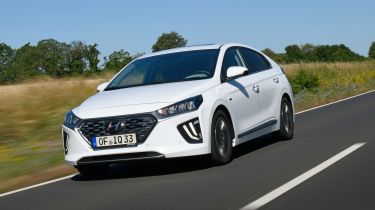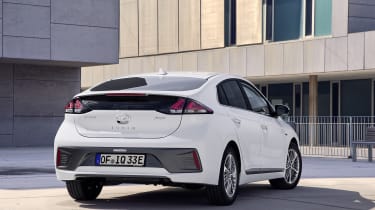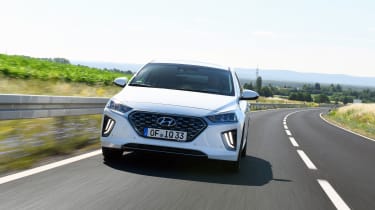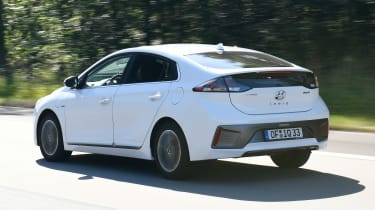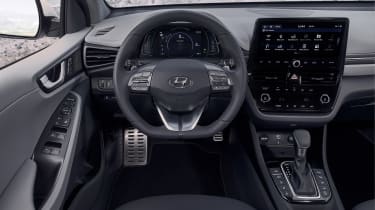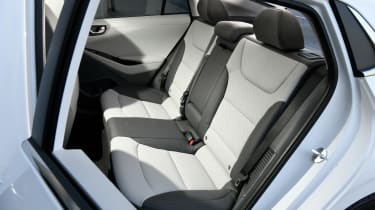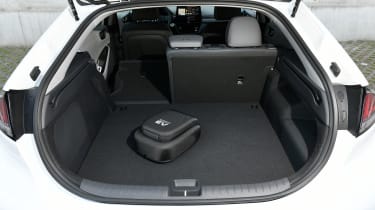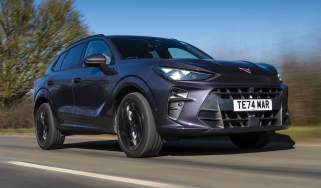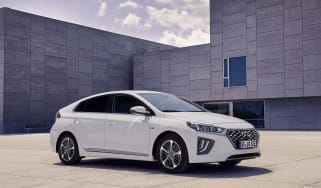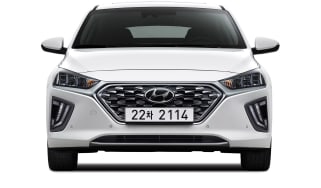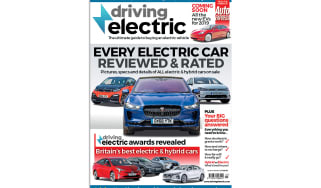Hyundai Ioniq Plug-In Hybrid review (2016-2022)
"The Ioniq Plug-in Hybrid offers similar economy to the Toyota Prius but it's cheaper and less common"
Pros
- Impressive economy
- Practical family car
- Comfortable
Cons
- Not exciting to drive
- Braking system can be jerky
- Some scratchy interior materials
If you’re looking for a family car with super-low running costs, the Hyundai Ioniq Plug-In Hybrid should definitely be on your shortlist. With a much larger battery capacity than the standard Hyundai Ioniq Hybrid and a petrol engine to eliminate the range anxiety associated with the all-electric model, it’s capable of stellar economy figures without any hassle.
Used to maximum effect, Hyundai claims the combination of battery life and petrol power can return up to 257mpg with CO2 emissions of just 26g/km.
Instead of the 43bhp electric motor fitted in the Ioniq Hybrid, the Plug-In Hybrid has a 60bhp unit, along with the same 104bhp 1.6-litre GDI petrol engine. This means performance is fractionally better, with 0-62mph taking around 10.6 seconds (instead of 10.8). Around town, the Hyundai has plenty of go off the line, and feels very similar to its main rival, the Toyota Prius Plug-In, although the Prius is half a second slower from 0-62mph.
The Ioniq is quick enough though, and its petrol engine is fairly hushed when it cuts in to assist the electric motor, creating a relaxing driving experience that’s particularly well-suited to towns and suburbia. You can select EV mode, which stops the petrol engine from running for an all-electric range of up to 39 miles - handy if the end of your journey is in a city. The Ioniq’s default mode is the Hybrid setting, which smoothly alternates between electric and petrol power. We wish we could say the relationship between the regenerative braking and standard disc brakes was as harmonious, as the different resistance between the two can lead to some jerky stops when slowing gradually.
More reviews
You probably wouldn’t expect the Ioniq to be a supreme driver's car, and low-rolling resistance tyres, light steering and the hybrid powertrain mean you’d be right. In its favour, the dual-clutch automatic gearbox (generally favourable to most rivals’ CVT systems) allows for some snappy gear changes and comfort is generally good, even if some harsh bumps can jar passengers.
Thanks to the Ioniq being designed around a plug-in hybrid powertrain from the outset, practicality hasn’t been compromised too much and there’s room for five people inside. The boot has 341 litres of luggage space, which is much more than the boot of the Prius Plug-In offers (191 litres). Both the Hyundai Ioniq Electric and Ioniq Hybrid offer a bigger boot than the Plug-in, however.
Hyundai is known for including plenty of equipment as standard, and the Ioniq Plug-In Hybrid is no exception, with LED headlights and an infotainment system featuring Apple CarPlay and Android Auto. There’s lots to keep fans of the latest technology happy but some of the materials aren't quite as pleasing, with a fair few scratchy plastics.
At least reliability is unlikely to be an issue, because the Ioniq comes with Hyundai’s long five-year/unlimited mileage warranty. The Ioniq has also received a five-star Euro NCAP crash test rating, with impressive scores across the board.
Overall, despite its slightly higher price, the extra fuel-economy of the Plug-In gives it a greater appeal than its conventional hybrid stablemate. Not only that, but we reckon it's more well rounded overall than the Toyota Prius Plug-In Hybrid it competes with.
MPG, running costs & CO2
The Ioniq Plug-In Hybrid is fitted with a lithium-ion battery with an 8.9kWh capacity, which is much smaller than the 38.3kWh battery capacity of the Ioniq Electric, hence its all-electric range of 39 miles being much lower than the 194-mile battery life the all-electric car can manage.
Yet, when coupled with the efficient 1.6-litre GDI petrol engine, economy figures of 257mpg and CO2 emissions of just 26g/km are claimed – low enough for London Congestion Charge exemption. As impressive as this claimed economy figure sounds, you’ll find yourself regularly home charging the battery pack or visiting a public charger to get close to the 257mpg figure.
Do so every day, and the EV range could be enough to cover the daily commute of most owners. The further you drive without recharging, the more the economy drops as the petrol engine has to do more of the work.
It’s not just the powertrain which makes the Ioniq Plug-In Hybrid economical, however, with aerodynamic bodywork allowing it to cut through the air more easily. There are also eco tyres and regenerative braking, which can be felt slowing the car when you come off the accelerator, putting energy back into the battery pack.
After the first year’s CO2-based road tax (generally wrapped up in the on-the-road price), the Ioniq Plug-In costs £135 a year to tax. The plug-in hybrid should also appeal strongly to company-car drivers, thanks to its low Benefit-in-Kind rating.
You can expect a charging time of around 2.5 hours from flat using a wallbox, with the time likely to increase to five hours if using a three-pin plug socket.
Engines, drive & performance
With a 60bhp electric motor coupled to a 104bhp 1.6-litre petrol engine, the Hyundai Ioniq Plug-In Hybrid has around the same performance as a turbocharged diesel car, accelerating from 0-62mph in just over 10.5 seconds. Thanks to the instant torque of its electric motor, the Ioniq feels quite brisk from a standstill, even if the Toyota Prius Plug-In ultimately feels faster once on the move.
The petrol engine cuts in with reasonable refinement when required, but the dual-clutch six-speed automatic gearbox can feel sluggish when changing up through the gears or if you suddenly need a spurt of acceleration, when overtaking for example. Similarly, the combination of regenerative braking and traditional steel brake discs can lead to a jerky feel when trying to slow the Ioniq down smoothly.
There are several driving modes to choose from, including an EV mode which keeps the Ioniq in all-electric mode until the battery life is almost drained. Using just the electric motor allows for smooth and very quiet progress in town, but with 60bhp on tap, you may start to hold up traffic along challenging country lanes or on motorway inclines. In hybrid mode, the Ioniq does a good job of juggling electric and petrol power, while attempting to use the electric motor more often than the Ioniq Hybrid model.
Tyres designed for maximum economy rather than grip, vague steering and the extra weight of its hybrid powertrain make for a competent rather than exciting drive. The handling is fuss-free, though, and ride comfort is generally good, too - even if some sharp bumps can be felt inside.
Interior & comfort
The Hyundai Ioniq’s interior might not raise the bar for design, but it does look fairly modern and provides plenty of creature comforts. The driving position is good, and everything is clearly labelled and easy to operate. The steering wheel is pleasant to hold and looks quite sporty, but some of the materials aren’t as soft to the touch and feel a bit cheap.
Equipment levels are very impressive, with the 10.25-inch touchscreen infotainment system a highlight thanks in large part to Apple CarPlay and Android Auto compatibility. The sat nav is easy to operate, too, with clear maps and spoken instructions. Other standard equipment includes heated front seats, wireless phone charging, dual-zone climate control, auto LED headlights, a reversing camera, adaptive cruise control and a configurable instrument display, which changes to reflect your chosen driving mode.
At low speeds, the Ioniq Plug-In Hybrid is almost silent, making it very quiet and relaxing. Pick up the pace and the petrol engine chimes in relatively quietly, but wind and tyre noise also increase to remind you this is a Hyundai, not a Rolls-Royce. The ride is aimed towards comfort too, ironing out all but the worst potholes.
Practicality & boot space
While some older plug-in hybrid models have had extra motors and battery packs shoehorned in wherever they will fit, the Ioniq was designed from the ground up to accommodate the extra bulk of its powertrain. This pays dividends inside, where five adults will fit with reasonable leg and headroom, despite the sloping roofline.
It’s a similar story with the boot, which is accessible via a large hatchback boot lid and has a reasonable 341 litres of space. This is much more than the Prius Plug-In, which has a small, 191-litre boot, and a similar figure to the Toyota Corolla and Mazda3. It’s worth noting that both the Ioniq Electric and Hybrid have bigger boots, at 357 and 443 litres respectively.
The charging cable can encroach on the load space slightly but if you’re in the habit of home charging, it can probably be left there. Another slight annoyance is the rear spoiler, which divides the back windscreen and can reduce visibility in the rear-view mirror, although in practice we didn’t find it too much of an issue.
Reliability & safety
The Ioniq was a new model but used some familiar parts, and there are few worries about its reliability. In our 2019 Driver Power owner satisfaction survey, it came a highly commendable eighth place out of the top 100 cars on sale, with its safety features, low running costs and reliability all praised by owners.
Hyundai is facing challenges, however, with a 22nd-place finish for the brand out of 30 manufacturers in our 2019 Driver Power survey. Only 13.1% of Hyundai customers reported a fault within the first year.
There should be no concerns regarding safety, with the Ioniq posting impressive Euro NCAP crash-test results. Despite the tests getting more stringent in recent years, the Ioniq easily obtained the full five stars, with an impressive 91% for adult occupant protection and 82% in the Safety Assist category, which takes into account the included safety technology.
Autonomous emergency braking is fitted as standard, along with lane-keeping assistance to help avoid drifting towards other traffic on the motorway. Blind-spot monitoring, a reversing camera and rear cross-traffic alerts also improve safety and help avoid parking bumps.
See how this car scored on our sister site DrivingElectric

